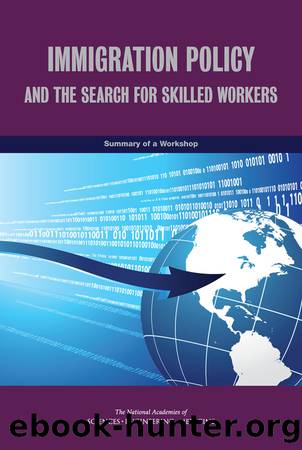Immigration Policy and the Search for Skilled Workers: Summary of a Workshop by Gail Cohen

Author:Gail Cohen
Language: eng
Format: epub
Publisher: The National Academies Press
Published: 2015-01-08T00:00:00+00:00
Domestic compared to former international student residents in Australia (2009-2011).
Note: * = Omitted field, given minimal response rates.
SOURCE: Analysis of Graduate Destination Survey Data, 2007-2011.
Hawthorne recounted what she called her favorite story from the many interviews she conducted as part of this study. A college in Melbourne that had a large number of Indian and Chinese students was producing electrical linesmen when that occupation was removed from Australiaâs in-demand job list. Overnight, that college changed its course offerings and started producing chefs, but with the same staff, the same students, and no kitchen. Due to the shortage of quality assurance inspectors, it took long time for the immigration department to catch on to what this school had done. In response to the proliferation of for-profit institutions with dubious credentials and poor student employment outcomes, Australia fine-tuned its study-migration program.3,4 The program now mandates higher language proficiency skills and allows fewer exemptions from testing. There was an improvement in quality assurance and removal of the poorly conceived migration incentives in the skilled occupation list, among others. The key changes involved greater reliance on employer or state sponsorship, increasing the number of points for greater English proficiency, and increasing the level of qualification needed for the study-migration pathway. The government also introduced a guaranteed right to stay and work after course completions for degree-qualified international students, with lengths of stay ranging from two years for those with Bachelorâs degrees to four years for PhD qualifications, in order to give those migrants time to position themselves for sponsorship by gaining work experience or improving their English proficiency, for example.
Hawthorne said that the initial decline in international student enrollment was significant, with the private vocational sector experiencing the biggest drop as expected. âBut being the intelligent people they are, international students did a global scan, realized there were still excellent study-migration pathways, and they recalibrated enrollment decisions so that they moved back into the university sector aligned with areas such as nursing that are constantly in demand,â she explained. While it is too early to determine the full impact of the policy changes that occurred between 2009 and 2011, the salaries paid to onshore migrants and those who pass through the study-migration pathway were on par with each other.
To assess how employers regarded international students compared to domestic graduates in identical fields, Hawthorne and her colleagues analyzed data from 2007 to 2011 from Australiaâs Graduate Destination Survey and looked at fields where there was sustained demand, an over-supply of labor, variable demand, and modest demand. One key finding from this analysis was that employers prefer native or near-native speakers of English, regardless of whether they were domestic or international students. For both native Australians and international students with Bachelorâs degree qualifications, there were âextraordinarily strong outcomesâ in high-demand fields such as medicine, dentistry, and pharmacy. Hawthorne noted that international medical students and nurses are proving to be a huge asset in building Australiaâs medical workforce. However, for fields such as accounting, business, and information
Download
This site does not store any files on its server. We only index and link to content provided by other sites. Please contact the content providers to delete copyright contents if any and email us, we'll remove relevant links or contents immediately.
| Automotive | Engineering |
| Transportation |
Whiskies Galore by Ian Buxton(41716)
Introduction to Aircraft Design (Cambridge Aerospace Series) by John P. Fielding(33013)
Small Unmanned Fixed-wing Aircraft Design by Andrew J. Keane Andras Sobester James P. Scanlan & András Sóbester & James P. Scanlan(32681)
Craft Beer for the Homebrewer by Michael Agnew(18078)
Turbulence by E. J. Noyes(7890)
The Complete Stick Figure Physics Tutorials by Allen Sarah(7260)
Kaplan MCAT General Chemistry Review by Kaplan(6817)
The Thirst by Nesbo Jo(6750)
Bad Blood by John Carreyrou(6470)
Modelling of Convective Heat and Mass Transfer in Rotating Flows by Igor V. Shevchuk(6351)
Learning SQL by Alan Beaulieu(6155)
Weapons of Math Destruction by Cathy O'Neil(6079)
Man-made Catastrophes and Risk Information Concealment by Dmitry Chernov & Didier Sornette(5872)
Digital Minimalism by Cal Newport;(5578)
Life 3.0: Being Human in the Age of Artificial Intelligence by Tegmark Max(5401)
iGen by Jean M. Twenge(5319)
Secrets of Antigravity Propulsion: Tesla, UFOs, and Classified Aerospace Technology by Ph.D. Paul A. Laviolette(5234)
Design of Trajectory Optimization Approach for Space Maneuver Vehicle Skip Entry Problems by Runqi Chai & Al Savvaris & Antonios Tsourdos & Senchun Chai(4951)
Electronic Devices & Circuits by Jacob Millman & Christos C. Halkias(4861)
